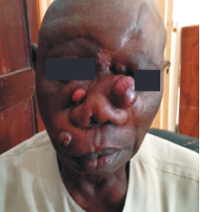Dermatofibrosarcoma protuberans in a 52years old man: A case report
Main Article Content
Abstract
Background
Dermatofibrosarcoma Protuberans (DFSP) is categorized as a skin tumour by WHO recent classification. It is slowing growing, nodular neoplasm of intermediate grade malignancy that is found almost exclusively in the dermis from which it often invades the subcutaneous tissue. Most cases are seen mainly in adulthood but it can also be seen in childhood. They are commoner in blacks, usually found on the trunk and as a group they are usually much larger than Dermatofibromas.
Case Presentation
We present the case of a 52years old retired driver with a 29years history of recurrent facial tumour. Has had excision 14 times in various hospitals prior to presentation to us. He sustained facial trauma from a fall while trying to collect water from a well some months prior to the growth of the first tumour. At presentation we found a middle aged man with multiple facial tumours, multiple facial scars, nasal dorsum deviation with reduced patency. He had various investigations done, which include computerized tomographic scan of the paranasal sinuses and brain that showed no brain, bone or sinuses affectation. Excision biopsy was done and histology report was that of dermatofibrosarcoma protuberans.
Conclusion
In multiple recurrences with previous surgical scars, it may not be possible achieving a good margin during excision as noticed in our case. For such cases adjuvant radiotherapy is of benefit in preventing recurrence.
Downloads
Article Details
Section

This work is licensed under a Creative Commons Attribution-NonCommercial-NoDerivatives 4.0 International License.
The Journal is owned, published and copyrighted by the Nigerian Medical Association, River state Branch. The copyright of papers published are vested in the journal and the publisher. In line with our open access policy and the Creative Commons Attribution License policy authors are allowed to share their work with an acknowledgement of the work's authorship and initial publication in this journal.
This is an open access journal which means that all content is freely available without charge to the user or his/her institution. Users are allowed to read, download, copy, distribute, print, search, or link to the full texts of the articles in this journal without asking prior permission from the publisher or the author.
The use of general descriptive names, trade names, trademarks, and so forth in this publication, even if not specifically identified, does not imply that these names are not protected by the relevant laws and regulations. While the advice and information in this journal are believed to be true and accurate on the date of its going to press, neither the authors, the editors, nor the publisher can accept any legal responsibility for any errors or omissions that may be made. The publisher makes no warranty, express or implied, with respect to the material contained herein.
TNHJ also supports open access archiving of articles published in the journal after three months of publication. Authors are permitted and encouraged to post their work online (e.g, in institutional repositories or on their website) within the stated period, as it can lead to productive exchanges, as well as earlier and greater citation of published work (See The Effect of Open Access). All requests for permission for open access archiving outside this period should be sent to the editor via email to editor@tnhjph.com.
How to Cite
References
McArthur GA: Dermatofibrosarcoma protuberans: a surgical disease with a molecular savior. Curr Opin Oncol. 2006, 18: 341-346.
Darier S, Ferrand M. Dermatofibrosarcomes progressifs et ricidivantes on fibrosarcomes de la peau. Ann Dermatol Venereol 1924; 5:545-562
Hoffmann E. Ueber das knollentribende Fibrosarkom der Haut (dermatofibrosarcoma protruberans). Dermatol Z 1925; 43:1-28
Sun LM, Wang CJ, Huang CC: Dermatofibrosarcoma protuberans: treatment results of 35 cases. Radiother Oncol. 2000, 57: 175-181.
Brabant B, Revol M, Vergote T, Servant JM, Banzet P: Dermatofibrosarcoma protuberans of the chest and the shoulder: wide and deep excisions with immediate reconstruction. Plast Reconstr Surg. 1993, 92: 459-462.
Fiore M, Miceli R, Mussi C: Dermatofibrosarcoma protuberans treated at a single institution: a surgical disease with a high cure rate. J Clin Oncol. 2005, 23: 7669-7675.
Abrams TA, Schuetze SM: Targeted therapy for dermatofibrosarcoma protuberans. Curr Oncol Rep. 2006, 8: 291-296.
Criscione VD, Weinstock MA: Descriptive epidemiology of dermatofibrosarcoma protuberans in the united states, 1973 to 2002. J Am Acad Dermatol. 2007, 56: 968-973.
Lemm D, Mugge LO, Mentzel T, Hoffken K: Current treatment options in dermatofibrosarcoma protuberans. J Cancer Res Clin Oncol. 2009, 135: 653-665.
Stojadinovic A, Karpoff HM, Antonescu CR: Dermatofibrosarcoma protuberans of the head and neck. Ann Surg Oncol. 2000, 7: 696-704.
McArthur GA: Molecular targeting of dermatofibrosarcoma protuberans: a new approach to a surgical disease. J Natl Compr Canc Netw. 2007, 5: 557-562
Chang CK, Jacobs IA, Salti GI: Outcomes of surgery for dermatofibrosarcoma protuberans. Eur J Surg Oncol. 2004, 30: 341-345.
Mendenhall WM, Zlotecki RA, Scarborough MT: Dermatofibrosarcoma protuberans. Cancer. 2004, 101: 2503-2508.
Mizutani K, Tamada Y, Hara K: Imatinib mesylate inhibits the growth of metastatic lung lesions in a patient with dermatofibrosarcoma protuberans. Br J Dermatol. 2004, 151: 235-237.
Wacker J, Khan-Durani B, Hartschuh W: Modified mohs micrographic surgery in the therapy of dermatofibrosarcoma protuberans: analysis of 22 patients. Ann Surg Oncol. 2004, 11: 438-444.
Bowne WB, Antonescu CR, Leung DH: Dermatofibrosarcoma protuberans: a clinicopathologic analysis of patients treated and followed at a single institution. Cancer. 2000, 88: 2711-2720

